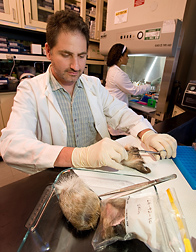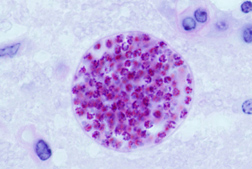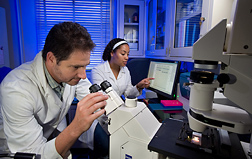A Family Tree for Toxoplasma
|
|
Scientists use DNA to track ancient evolutionary lineages and genetic migrations for a range of animals—including modern humans. ARS zoologist Ben Rosenthal is tracing the family tree of one of the most widespread parasites of warm-blooded vertebrates, Toxoplasma gondii.
“The most rewarding part of this research has been satisfying a basic curiosity about T. gondii’s history—which has also helped reveal a possible key to its ongoing success,” says Rosenthal, who works in the ARS Animal Parasitic Diseases Laboratory in Beltsville, Maryland.
Parasites have always been enthusiastic partners in the evolutionary gamble to explore and adapt. T. gondii has had an additional advantage in this struggle: It can reproduce both clonally—simply by dividing itself in two—and sexually.
People and other animals become infected with T. gondii after ingesting soil or water contaminated with T. gondii eggs or by consuming meat that contains dormant parasites encased in cysts. After it is ingested, the parasite has a brief period of activity and then burrows into the body tissues of its new host to resume its dormant state.
But when ingested by a cat, these dormant parasites wake up and complete a cycle of sexual reproduction. This provides the parasite with its only opportunity to generate genetically unique individuals that possess a combination of parental attributes. When cats excrete the resulting egglike oocysts into the environment, other warm-blooded animals—including people—are exposed to the genetically novel parasite strains.
Experts believe that some 25 percent of the global human population is chronically infected with T. gondii. Though most people don’t develop any symptoms, the parasite can cause health complications in individuals with weakened immune systems and in infants who acquire infections in the womb from their infected mothers.
So when did this organism start out on the road to parasitic success? To find out, Rosenthal worked with ARS microbiologist Jitender Dubey and biologist David Sibley at the Washington University in St. Louis School of Medicine to analyze DNA snippets from 46 T. gondii strains found around the planet.
Using statistical programs to group the DNA data, the team concluded that all the T. gondii specimens in their study arose from a common ancestor that lived at least 10 million years ago. This one strain gave rise to four ancient groups of T. gondii—two in South America, one in North America, and one with a global distribution. By 1 million years ago, the genetic material from these four ancient groups had been redistributed among 11 distinct groups of T. gondii. These 11 groups, in turn, gave rise to the 46 strains currently found worldwide.
|
|
The Great Divide
“We know that by around a million years ago, the Panamanian land bridge had formed between North and South America, which provided a route for migration between the two continents,” Rosenthal says. “And cats used that route to spread from North America to South America. When the cats went south, they probably took T. gondii with them.”
The existing South American strains studied by Rosenthal’s group exhibited the genetic diversity expected in an organism that has been evolving for more than a million years in one geographic region. This variety was facilitated by the parasite’s sexual reproduction in cats, which increased the opportunities for DNA mixing between types.
In stark contrast, more than 95 percent of the T. gondii strains in North America and Europe—which have also been diversifying for millions of years—are dominated by only a few types.
Time for a Change
To their great surprise, Rosenthal and his colleagues discovered that one of the parasite’s chromosomes has spread throughout the American populations within the last 10,000 years, despite the fact that North American and South American parasite populations have otherwise been evolving in geographic isolation for 1 million years. This adaptation is now carried by essentially all T. gondii strains in North America and by many South American types.
After studying patterns in its DNA, the team concluded that this genetic innovation—which they named “Chr1a”— probably developed in a single T. gondii strain from North America or Europe. As it successfully became established in other T. gondii populations, it maintained a remarkable consistency for a heritable trait.
“This uniformity suggests that Chr1a is valuable to the parasite’s survival and reproduction, but its exact role remains the subject of ongoing study. We think it would be important to figure out whether Chr1a somehow affects the parasite’s transmission or its disease potential, because T. gondii strainsdiffer in the nature and severity of disease they cause,” Rosenthal explains.
The Good Side of Bad Parasites
In the right setting, T. gondii becomes an asset instead of a problem. “It’s a great lab model for studying other parasites,” Rosenthal says. “Its makeup is very similar to the parasite that causes malaria and other parasites that threaten animal and human health.”
But T. gondii still requires careful monitoring outside of the lab. “Toxoplasmosis causes birth defects worldwide,” Rosenthal continues. “We hope that by understanding how T. gondii has evolved and disseminated, we will more effectively limit future human exposure both here and abroad.”
A paper reporting the results of this study was published in the Proceedings of the National Academy of Sciences of the United States of America in July of 2007.—By Ann Perry, Agricultural Research Service Information Staff.
This research is part of Food Safety, an ARS national program (#108) described on the World Wide Web at www.nps.ars.usda.gov.
Benjamin M. Rosenthal is with the USDA-ARS Animal Parasitic Diseases Laboratory, Beltsville Agricultural Research Center, 10300 Baltimore Ave., Bldg. 1180, Beltsville, MD 20705-2350; phone (301) 504-5408, fax (301)504-8979.

"A Family Tree for Toxoplasma" was published in the September 2008 issue of Agricultural Research magazine.









